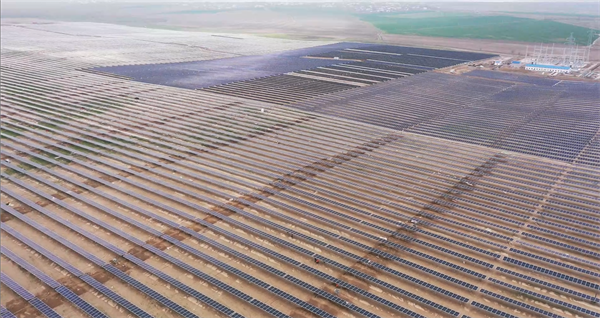With spring approaching, more than 450 AI-powered cleaning robots developed by Dongfang Electric Corporation (DEC) are operating at the Samarkand solar photovoltaic (PV) plant in Uzbekistan.

AI-powered cleaning robots developed by Dongfang Electric Corporation are operating at the Samarkand solar photovoltaic (PV) plant in Uzbekistan. [Photo/sasac.gov.cn]
Covering approximately 4.5 million square meters — equivalent to more than 610 football fields — the once-deserted area now hosts an expansive array of solar panels maintained by smart cleaning robots. These robots significantly enhance the efficiency and lifespan of the PV modules, ensuring that clean energy is continuously delivered to the local grid and storage systems.
Since its grid connection in April 2024, the AI cleaning fleet has accumulated over 3.6 million operating hours, becoming a beacon of smart energy powering Central Asia’s transition towards sustainable energy.
From “unsolvable problem” to “AI breakthrough”
When the Samarkand PV project was first proposed, harsh weather conditions made traditional manual cleaning impractical and costly. Facing this challenge, the DEC team turned to innovation, developing AI cleaning robots specifically adapted to the local environment.
In February 2024, the robots began operations, autonomously optimizing heating and panel tilt to accelerate snow removal — achieving 17 times the efficiency of manual labor.
From “manual monitoring” to “autonomous scheduling”
Samarkand’s extreme and shifting climate demands constant adaptability. The AI cleaning robots respond automatically to snow, dust and structural changes — melting ice, adjusting panel angles and intensifying cleaning when needed. They also detect early signs of equipment issues and schedule maintenance, significantly improving efficiency and reducing failures compared to manual methods.
From “cleaner” to “data analyst”
Each robot on DEC’s intelligent O&M platform is also a data processor. They continuously gather and analyze snow and dust patterns to refine cleaning strategies.

A view of the Samarkand solar photovoltaic (PV) plant in Uzbekistan [Photo/sasac.gov.cn]
Before a major dust storm in March 2024, robots preemptively adjusted panel angles to reduce dust buildup—cutting annual cleaning mileage by 17,000 kilometers. Equipment health monitoring, based on parameters like bolt vibration and inverter temperature, have enabled early detection of component wear, significantly lowering maintenance costs.
By prioritizing cleaning tasks based on weather forecasts and real-time data, the robots have boosted daily power generation by 11 percent on average compared to expectations.
The Samarkand PV project now powers 260,000 households annually, reducing carbon dioxide emissions by approximately 230,000 tons.
(Executive editor: Wang Ruoting)